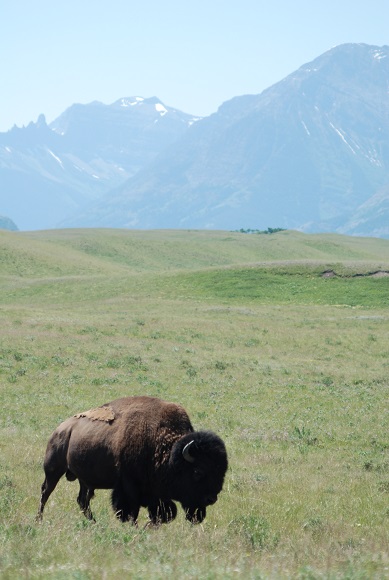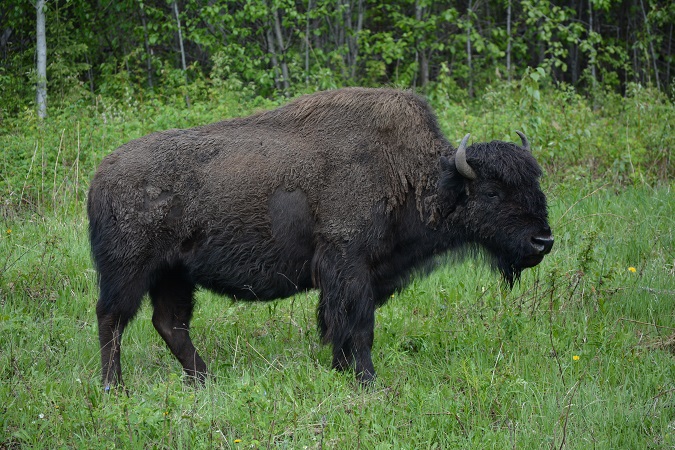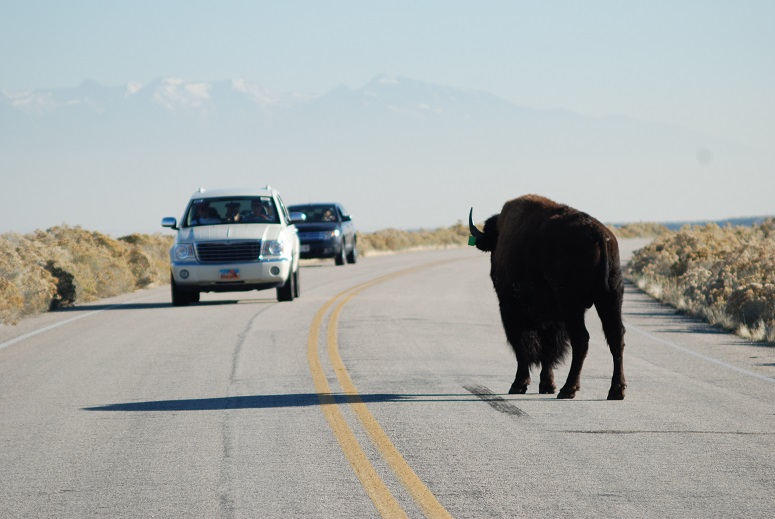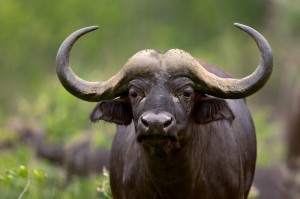
There are two different North American Bison
Updated June 2024 to show current populations and distribution.

North America has two types of Bison: the Plains Bison and the Wood Bison.
Although “Buffalo” is a widely used name for this North American animal, it is not the correct name. When Europeans first came to western North America, they saw the Bison, and not knowing what it was, they called it a buffalo, and the name stuck.
Buffalo
Here is a photo of a Buffalo. They live in African and Asia. The North American animal is not a Buffalo, although that name is commonly used.
Near Extinction
Bison once existed in the millions on the prairies of western North America. In the late 1800s, they were hunted almost to extinction for their hides, which made warm winter coats and hats. The carcasses were mostly left to rot, although it is a nutritious food source. By 1900, approximately 25 million animals were reduced to less than 1,000 (about 600 in the USA and 400 in Canada). The American government had no plans to prevent their extinction. Fortunately, a few far-sighted private citizens intervened to prevent this, and the remaining herds were gathered up and kept on private ranches.
The differences between Plains Bison and Wood Bison


Photos above of the two different types. Do you know which is which? Answer at the bottom.
The Plains Bison lived traditionally across the vast prairies of western North America, while the wood bison lived in the northern Boreal Forest. Most people may not notice it, but there are several differences between these two animals.
The Plains Bison cows weigh about 410 kg (904 pounds). Bulls weigh 730 kg (1,610 pounds). The Wood Bison is the largest land mammal in North America, their weight being about 10 to 15 per cent more than the Plains Bison, with bulls weighing in at an average of 840 kg (1,852 pounds), some getting to more than 900 kg (1,985 pounds). The Plains Bison has no obvious neck. They appear to have their head attached directly to their body, whereas the Wood Bison has a visible neck.
The Plains Bison has a rounded hump on its back. The Wood Bison has a slightly square-shaped hump. Their hair is different. The Plains Bison has hairy forelegs. The Wood Bison does not have much hair below the knee. The Wood Bison is darker in colour than the Plains Bison. The hairy cape that covers the front half of the animal has an obvious boundary on the Plains Bison, with a distinct line between the hairy front half and the bare rear half of the animal. On the Wood Bison, these two areas blend without a distinct boundary. One of the best ways to determine the difference is by looking at their horns. Their heads are a different shape. Plains Bison have a larger head, and the horns do not reach above it. On the Wood Bison, the horns stick up above the head. The highest point of the Wood Bison is well ahead of its front legs, while the Plains Bison’s highest point is directly above the front legs
..Reintroduction
In 1907, the Canadian government purchased a privately owned herd of Plains Bison in Montana and moved into a new park called Buffalo National Park in Alberta. With no one hunting them, the population increased dramatically.
Wood Buffalo National Park
In 1922, Wood Buffalo National Park was established in northern Alberta and southern Northwest Territories to preserve the endangered Wood Bison. By the early 1900s, they were extremely rare and thought to be perhaps extinct. But a few were saved, and today, the population numbers about 7,000. You can see them in Canada’s Northwest Territories and northern British Columbia.
Many Plains Bison were transferred from the overpopulated herd at Buffalo National Park to Wood Buffalo National Park. In 1939, due to the outbreak of World War II, Buffalo National Park was changed to a military base and is now called Canadian Forces Base Wainwright. More than 6,000 Plains Bison from Buffalo National Park were moved to Wood Buffalo National Park in northern Alberta.
Bison often carry diseases, such as bovine brucellosis and tuberculosis, that they catch from domestic cattle. When the Plains Bison were moved to Wood Buffalo National Park, they brought these diseases. This was a disaster for the resident Wood Bison, who soon caught the infectious disease. In 1963, a small herd of disease-free Wood Bison were discovered in a remote part of Wood Buffalo National Park. These animals had not yet come into contact with the Plains Bison. These 18 animals were captured and moved to a new location named the MacKenzie Bison Sanctuary, located near Fort Providence, Northwest Territories, which is on the other side of the Great Slave Lake. Today, the herd numbers more than 2,000. A Bison-free zone was created between MacKenzie and Wood Buffalo to prevent the two herds from mixing, thus spreading disease and hybrid animals. The Wood Bison are also in danger of becoming extinct due to hybridization with the Plains Bison, thus destroying their unique genes.
Grasslands National Park
In 2006, Plains Bison were reintroduced in Grasslands National Park in southern Saskatchewan. This was the first time Bison had wandered on the short-grass prairie in more than 100 years. I went there last year, and it was great to see them in their natural habitat once again.
Bison in Russia
In 2006, 2011 and 2013, some animals were shipped from Canada to Russia to reintroduce the species there. The population in eastern Russia now numbers about 500.
Bison Today
Today, the Bison population is about 350,000 to 400,000 Plains Bison and between 5,000 and 7,000 Wood Bison. They have been reintroduced to several parks in North America, including Yellowstone National Park in the USA and Elk Island and Prince Alberta National Parks in Canada. In 1918, 31 Bison were released in Banff National Park, Alberta, Canada. Although the traditional range of the Plains Bison was the prairies, they are adaptable animals and can live quite well in the forest.
In 2015, Wood Bison were released in Alaska after being absent for more than 100 years. They were brought to Alaska from Elk Island National Park in Alberta, Canada and released in a very remote area in southwest Alaska. The population in Alaska is now about 140.
Free-roaming Bison


By the early 1900s, they were almost extinct, but today, there are many places where you can see free-roaming Bison (not in a zoo or compound). Here is a link to another page on my website that tells you where to view them in the wild.
European Bison
There are slight differences between North American and European Bison. The European version is taller but lighter in weight.
European Bison were hunted almost to extinction by 1927. Both Allied and German soldiers killed many during the First World War. The last wild Bison in Europe was shot in 1921, and the last one in Asia was shot in 1927. By 1927, only 48 remained, all in zoos.
By 1964, the population reached 100. Some were released in Poland. By 2014, the population in Poland was 1,212 in the wild and 222 in zoos.
Besides Poland, small herds now exist in Lithuania, Belarus, Ukraine, Romania, Slovakia, Latvia, Kyrgyzstan, European Russia, and Germany. Recent introductions have been made in Moldova, Spain, Denmark, Czechia and Bulgaria. In 2022, a small group was released in Canterbury, UK.
Today, the population reached about 6,000.
Bison in Ukraine
A small herd of European Bison lived at a national park near Kyiv. During Russia’s invasion, many of them were killed, including all of the males. Now that the situation around Kyiv has stabilized, Ukraine is now attempting to bring in a male from another park. The World Wildlife Fund will cover the cost of transporting the animal, which is estimated to be 10,000 Euros.
Photo Answer
The photo on the left is of the Plains Bison, and the one on the right is of the Wood Bison.
